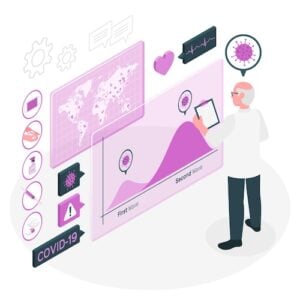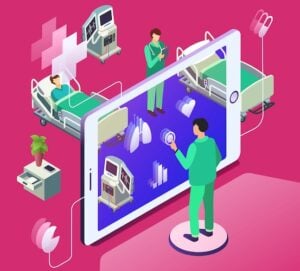Today, the pressure on clinical CIOs and VPs of Technology to enhance patient outcomes while optimizing operational efficiency has never been greater. The successful clinical decision support implementation stands at the forefront of this challenge, offering transformative potential yet often mired in complexity.
Imagine a seamless integration where data-driven insights empower your clinical teams to make informed, timely decisions. A world where technology not only supports but anticipates the needs of both patients and providers. This isn’t a distant dream but a tangible reality within reach.
Our guide delves beyond the surface, providing you with actionable strategies and insider insights to navigate the intricacies of CDSS implementation. Welcome to your roadmap for turning visionary aspirations into operational triumphs.
Top Takeaways
- For effective CDSS implementation, CIOs should consider customizable off-the-shelf solutions over building from scratch. These options integrate seamlessly, offer scalability, and save time and resources, ensuring swift, efficient deployment.
- Implementing Clinical Decision Support Systems unlocks opportunities like improved patient engagement, data-driven decision-making, streamlined regulatory compliance, and personalized medicine, significantly enhancing patient outcomes and healthcare efficiency.
- Effective CDS implementation hinges on change management, customization, scalability, regulatory compliance, and a patient-centered approach. Leveraging AI for advanced analytics and continuous learning can further enhance clinical decision-making and operational efficiency.
Table of Contents
What Is a Clinical Decision Support System (CDSS)?
Types of CDSS
Pros and Cons of Clinical Decision Support Systems
How to Implement Clinical Decision Support Systems
- Step 1: Assess needs and set objectives
- Step 2: Build a cross-functional team
- Step 3: Select the right CDSS
- Step 4: Ensure data quality and interoperability
- Step 5: Integrate with existing systems
- Step 6: Train the personnel
- Step 7: Maintain: monitor, evaluate, and update
Best Practices for Implementing CDS
Overcoming Challenges in CDSS Implementation
Leveraging Opportunities with CDSS
Future of Clinical Decision Support Systems
How Topflight Can Help
What Is a Clinical Decision Support System (CDSS)?
Defining CDSS
A Clinical Decision Support System (CDSS) is a sophisticated health information technology system designed to assist physicians and other healthcare professionals in making data-driven clinical decisions. By integrating patient data with evidence-based guidelines, CDSS provides real-time, actionable insights that enhance the decision-making process, ultimately improving patient outcomes and operational efficiency.
Core Components and Functionalities of CDSS
To fully appreciate the value of implementing clinical decision support systems, it’s essential to understand their core components and functionalities. Below are some key elements that comprise a typical CDSS:
Order Sets
One of the fundamental features of CDSS is its ability to recommend appropriate medications, tests, or procedures based on a patient’s condition and medical history. For instance, if a patient is diagnosed with hypertension, the system can suggest antihypertensive medications tailored to their specific health profile.
This ensures that treatment plans are consistent with established guidelines, reducing variability in care and enhancing treatment efficacy.
Clinical Guidelines
CDSS integrates summaries of evidence-based best practices for managing specific conditions. These guidelines serve as a reference point for clinicians, ensuring that patient care aligns with the latest research and consensus in the medical community.
For example, when treating a diabetic patient, the system can provide comprehensive guidelines on managing blood glucose levels, thereby standardizing care and reducing the likelihood of complications.
Drug Interaction Alerts
One of the most critical functionalities of CDSS is providing drug interaction alerts. When prescribing medications, the system warns clinicians of potential adverse reactions between prescribed drugs. This feature is particularly valuable in preventing harmful drug interactions, which can lead to severe patient outcomes.
For example, if a clinician prescribes a new medication that may interact with a patient’s current prescription, the CDSS will alert the clinician, allowing them to reconsider or adjust the prescription accordingly.
Dosage Reminders
CDSS also offers dosage reminders, recommending appropriate dosages based on factors such as a patient’s weight, age, and kidney function. This functionality is crucial in avoiding medication errors, especially in populations where dosing needs to be carefully calibrated, such as pediatric or geriatric patients.
Diagnostic Support
Last but not least, CDSS provides diagnostic support by offering suggestions for potential diagnoses based on a patient’s symptoms and test results. Leveraging algorithms and vast medical databases, the system can present differential diagnoses that clinicians might consider.
This feature not only aids in accurate diagnosis but also speeds up the diagnostic process, enabling timely intervention. For example, if a patient presents with a complex array of symptoms, the CDSS can help narrow down the possible conditions, guiding the clinician toward the most likely diagnosis.
Additional Core Components and Functionalities of CDSS:
Here’s a list of add-on features worth considering when exploring clinical decision support implementation:
- Patient Safety Alerts: Alerts for potential patient safety issues such as allergies, contraindications, and duplicate therapies.
- Predictive Analytics: Tools that use historical and current data to predict patient outcomes and suggest preventive measures.
- Documentation Support: Assistance with accurate and efficient clinical documentation to ensure compliance and streamline billing processes.
- Population Health Management: Tools that help in managing and analyzing health data of populations to identify trends, allocate resources, and plan interventions.
Types of CDSS
Clinical decision support platforms present a variety of options tailored to different clinical environments and needs. Understanding these types is essential for developing an effective clinical decision-support project plan and leveraging the full potential of these systems.
Overview of Different Types of CDSS
CDSS can be categorized based on several factors, including their underlying technology, form, delivery mode, function, target user, specialization, and accessibility. This classification helps in selecting the most appropriate system for specific healthcare settings.
Knowledge-Based vs. AI-Driven CDSS
- Knowledge-Based CDSS: These systems rely on a comprehensive repository of clinical knowledge. They provide recommendations and alerts based on predefined rules and evidence-based guidelines. For example, a knowledge-based system might include order sets that recommend appropriate medications, tests, or procedures based on a patient’s condition and medical history.
- Machine Learning-Based CDSS: Leveraging artificial intelligence and machine learning, these systems evolve by learning from new data over time. They can identify patterns and predict outcomes, potentially offering more personalized and accurate recommendations. For instance, an AI-based CDSS might predict patient deterioration by analyzing vital signs and historical data.
Form: Standalone Software Suite vs. Integrated Module
- Standalone Software Suite: These are independent applications specifically designed for clinical decision support (CDS). They may require separate login credentials and operate outside of the primary EHR system, which could potentially add steps to the workflow but offer specialized functionalities.
- Integrated Module: These systems are embedded within the electronic health records or medical practice management system, ensuring seamless access and integration with patient data. Integration minimizes disruptions in clinician workflow and promotes more efficient utilization of CDSS features.
Delivery Mode: Passive vs. Active CDSS
- Passive CDSS: Provides information and recommendations that clinicians can opt to review at their discretion. The system acts as a reference tool rather than actively pushing alerts.
- Active CDSS: Actively engages users by delivering alerts, reminders, and recommendations directly into the clinical workflow. For example, active systems might issue drug interaction alerts when a clinician tries to prescribe medications that could potentially lead to adverse reactions.
Core Function
- Diagnosis Decision Support System: Helps clinicians in diagnosing patient conditions by matching symptoms and clinical data against a database of known diseases.
- Drug Decision Support System (DSS): Focuses on medication management, including dosing, drug interactions, and allergies.
- Order Entry Systems: Assists with ordering the correct tests, treatments, and procedures, reducing errors and optimizing patient care.
- Clinical Reminders Systems: Provides timely reminders for preventive care measures, such as vaccinations or routine screenings.
Target User: Clinician vs. Non-Clinician
- Clinician-Focused CDSS: Designed to aid doctors, nurses, and other medical staff in making informed clinical decisions.
- Non-Clinician CDSS: Tailored for administrative staff or patients themselves, for instance, tools that help patients manage chronic conditions by providing personalized health advice based on real-time data; for automating any below-license tasks.
Specialization: General vs. Specialty-Specific CDSS
- General CDSS: Applicable across various specialties, providing broad support for multiple conditions and treatments.
- Specialty-Specific CDSS: Tailored to the needs of specific medical fields, such as cardiology or oncology, offering highly specialized guidance.
Accessibility: Mobile vs. Desktop
- Mobile CDSS: Accessible via smartphones and tablets, offering flexibility and convenience for healthcare providers on the go. Does the system include healthcare apps for patients?
- Desktop CDSS: Typically part of the EHR system used in clinical settings, providing robust functionalities that might be more suitable for detailed data entry and review.
Best-Suited Types for Various Clinical Environments
Different clinical environments have unique requirements that dictate the choice of CDSS type:
- Primary Care Settings: In primary care, where clinicians deal with a wide range of conditions, general, knowledge-based CDSS integrated into the electronic medical system works well. These platforms should focus on providing up-to-date clinical guidelines and reminders to support preventive care.
- Specialty Clinics: Specialty-specific CDSS, particularly those that are machine learning-based, can offer detailed insights and innovative solutions tailored to complex cases seen in specialized clinics like oncology or cardiology.
- Large Health Systems: For large health systems, integrated modules that offer both passive and active decision support features can ensure consistency across different departments while allowing customization based on departmental needs.
- Mobile Clinics and Home Health Services: Mobile-accessible CDSS are essential for clinicians who need to provide care outside traditional clinical settings. These systems should be lightweight but capable of delivering critical alerts and recommendations in real time.
Implementing the right type of CDSS in your clinical decision support projects is crucial for maximizing its impact. By understanding the variety and functionality of CDSS, you can choose systems that best align with your clinical environment’s unique needs and challenges.
Pros and Cons of Clinical Decision Support Systems
The journey towards a successful CDSS implementation is marked by numerous benefits and some challenges. Clinical Decision Support Systems offer transformative potential, but like any technology, they come with their own set of pros and cons.
Advantages of Implementing CDSS
Enhanced Quality of Care
A well-implemented CDSS can significantly improve the quality of patient care. By providing real-time access to evidence-based guidelines and protocols, CDSS ensures that healthcare providers make informed decisions.
Data Says Yes: Research has shown that both commercial and locally developed CDSSs have positively impacted healthcare process measures. They have enhanced the performance of preventive services (n= 25; odds ratio [OR], 1.42 [95% CI, 1.27 to 1.58]), streamlined the ordering of clinical studies (n= 20; OR, 1.72 [CI, 1.47 to 2.00]), and improved the prescribing of therapies (n= 46; OR, 1.57 [CI, 1.35 to 1.82]).
Improved Patient Outcomes
CDSS has a direct impact on critical patient outcome metrics such as readmission rates and length of stay; patients receive timely and precise care. These implications may extend even further and reduce patient no-shows.
Data Says Yes/No: Research indicates that CDSS can positively affect patient outcomes, although the effectiveness can vary based on factors like disease type and CDSS criteria.
Increased Workflow Efficiency
One of the standout benefits of integrated healthcare through CDSS is its ability to streamline clinical workflows. By integrating seamlessly into existing EHR systems and other clinical software, CDSS minimizes redundant tasks and helps healthcare providers focus on patient care.
Read more on clinical workflow automation
Data Says Yes: Evidence from high-quality systematic reviews shows that CDSS significantly improved practitioner performance in a notable percentage (57%) of hospital settings studied, underscoring its potential to enhance operational efficiency in clinical environments.
Return on Investment (ROI)
From an administrative perspective, CDSS can deliver substantial financial benefits. By reducing medical errors, unnecessary tests, and hospital readmissions, CDSS helps healthcare organizations save costs. Additionally, improved patient outcomes and operational efficiencies contribute to a higher ROI: increase revenue in medical practices.
Data Says Yes: For instance, one Midwestern hospital discovered they were frequently over-ordering B-type natriuretic peptide (BNP) tests. By implementing corrective measures, they successfully reduced inappropriate BNP orders by 33%-43%.
Another compelling example comes from Good Shepherd Medical Center in East Texas. After implementing the TheraDoc clinical surveillance system, the hospital saw a remarkable 105% increase in monthly clinical interventions, improving from 1,986 to 4,065. This boosted communication and collaboration among pharmacy clinicians, medical staff, nursing, and case management. The financial impact was significant, with annual cost savings estimated at nearly $3 million and a 96% increase in annual savings, equating to a $1.47 million return on investment.
Disadvantages of Implementing CDSS
Initial Costs and Resources
Implementing a CDSS requires significant initial investment in terms of both financial resources and time. The process involves purchasing software, integrating it with existing systems, training staff, and ongoing maintenance. These upfront costs can be a deterrent for some healthcare organizations.
Potential Workflow Disruptions
While CDSS aims to enhance workflow efficiency, the initial stages of implementation can cause temporary disruptions. Healthcare providers may face a learning curve as they adapt to new systems and processes. This adjustment period can temporarily slow down operations and create resistance among staff who are accustomed to traditional workflows.
Data Privacy and Security Concerns
Implementing CDSS involves handling sensitive patient information, which raises potential risks related to data breaches and cyber-attacks. Ensuring robust security measures and compliance with regulations such as HIPAA is crucial to mitigate these risks.
Over-Reliance on Technology
There’s a risk that healthcare providers might become overly reliant on CDSS, potentially undermining their clinical judgment. While CDSS provides valuable support, it should complement—not replace—clinical expertise. It’s essential for clinicians to maintain a balance between utilizing technology and applying their professional judgment in patient care.
“Even when using valid clinical decision support tools, medical professionals must apply critical thinking, clinical judgment, and additional diagnostic testing as needed to validate CDS recommendations.”
Peter Kolbert, JD, Senior Vice President for Claim and Litigation Services for Healthcare Risk Advisors
Real-world Examples of Successful CDSS Implementation
TREWS by Johns Hopkins University
Johns Hopkins University developed the Targeted Real-Time Early Warning System for sepsis management. Used across five hospitals over two years, TREWS significantly enhances the early detection of sepsis—one of the most critical and elusive conditions in healthcare. Here are some compelling statistics:
- Detection Efficiency: TREWS successfully identified 82% of over 9,800 retrospectively confirmed sepsis cases early.
- Faster Treatment: For patients whose alerts were confirmed within 3 hours, there was a notable 1.85-hour reduction in the time to first antibiotic order.
- Improved Outcomes: A prospective study involving 6,800 patients demonstrated that timely confirmation of TREWS alerts led to reduced in-hospital mortality rates.
Learn more about how to develop a hospital management system in our dedicated blog.
Intermountain Healthcare’s ePNa System for Pneumonia Management
Intermountain Healthcare implemented the electronic pneumonia decision support (ePNa) system across 16 community hospitals, significantly improving pneumonia care. Key outcomes:
- 38% Reduction in Mortality: The ePNa system contributed to a substantial 38% relative reduction in mortality 30 days post-diagnosis.
- 17% Increase in Outpatient Disposition: More patients were safely treated and discharged without hospitalization, marking a 17% increase in outpatient disposition.
- Decreased ICU Admissions: Intensive care unit admissions saw a significant reduction, all while maintaining patient safety.
- Faster Antibiotic Administration: The system successfully lowered the mean time from emergency department admission to the start of the first antibiotic.
By understanding the pros and cons of CDSS, healthcare organizations can better navigate the complexities of CDSS implementation, ultimately enhancing clinical decision-making and improving patient care.
How to Implement Clinical Decision Support Systems
Implementing a Clinical Decision Support System can be a transformative initiative for any healthcare organization. However, it requires careful planning, thorough execution, and continuous monitoring to ensure success. In this section, we provide comprehensive, actionable steps for how to implement a clinical decision support system effectively:
- Step#1: Assess needs and set objectives
- Step#2: Build a cross-functional team
- Step#3: Select the right CDSS
- Step#4: Ensure data quality and interoperability
- Step#5: Integrate with existing systems
- Step#6: Train the personnel
- Step#7: Maintain: monitor, evaluate, and update
Step#1: Assessing Needs and Setting Objectives
Before diving into the implementation process, it’s crucial to identify the specific clinical challenges your organization faces. This means understanding areas where decision support can provide the most benefit. For example, is there a need to
- reduce medication errors,
- improve diagnostic accuracy,
- or streamline workflow efficiency?
A thorough needs assessment sets the foundation for a successful CDSS implementation.
Once the needs are identified, define specific, measurable, achievable, relevant, and time-bound (SMART) goals for your CDSS implementation. Do you aim to reduce readmission rates by 15% within a year? Or perhaps decrease the wait time for patients by 20 minutes? Clear objectives will guide the entire project and provide benchmarks for success.
Step#2: Team Building
Assemble a team that includes clinicians, IT staff, administrators, and data analysts. This diverse group brings different perspectives and expertise, essential for handling the multifaceted nature of CDSS implementation.
- clinicians understand the practical needs and challenges
- IT staff manage technical aspects
- administrators oversee logistics
- data analysts ensure the quality and integrity of clinical information
Clearly define the roles and responsibilities of each team member to ensure accountability throughout the project. Who will lead the training sessions? Who is responsible for data integration? Defining these roles helps prevent overlap and ensures every aspect of the project is managed efficiently.
Step#3: Selecting the Right CDSS
Choosing the right CDSS is critical. Consider factors such as ease of integration with existing systems, user-friendliness, scalability, and vendor support. The system should align with your organization’s current infrastructure and future growth plans.
- Leveraging Open Access Resources: Ensure the CDSS utilizes open-access clinical guidelines and research. This promotes transparency and enables continuous updates with the latest evidence-based practices, which is crucial for maintaining an effective and up-to-date system.
Conduct thorough evaluations of potential CDS software vendors. This includes demonstrations, reference checks, and pilot tests. Review practice guidelines provided by vendors to ensure their solutions meet your specific needs. It’s also beneficial to engage in a systematic review of available options to make an informed decision.
NB: if no existing solutions meet your specific needs, developing a CDSS from scratch is a viable option. Leveraging FHIR and SMART on FHIR technologies allows you to create CDS experiences that integrate seamlessly with EHR systems, balancing customization and cost-efficiency. However, if you opt to build from the ground up, brace for a lengthy process and budget accordingly.
Step#4: Ensuring Data Quality and Interoperability
- Data Standards: Ensuring that your CDSS adheres to healthcare data standards such as HL7, FHIR, and LOINC is essential for maintaining high data quality and interoperability. These standards facilitate seamless data exchange and integration between different healthcare information systems.
- Data Governance: Implement robust data governance practices to maintain data quality, accuracy, and consistency. This includes establishing protocols for data entry, validation, and regular audits to ensure that the information used by the CDSS remains reliable and up-to-date.
Step#5: Integrating with Existing Systems
Plan for seamless integration with existing EHRs and other clinical systems. This ensures that data flows smoothly between systems, allowing clinicians to access patient-specific information without disruption. Integration is crucial for the CDSS to function effectively within the clinical workflow.
Consider a phased approach to implementation. Start with developing one standalone module that integrates with the EHR and automates a specific workflow. This allows for testing and refinement before a full-scale rollout.
Need more details? Our play-by-play on how to build a SMART on FHIR app shows exactly how to surface that data in a CDS widget without writing custom EHR code.
Step#6: Training and Engaging Clinicians
Develop and deliver comprehensive training programs tailored to different user groups. Training should cover not just how to use the CDSS but also best practices in clinical decision-making and how the system fits into the existing workflow.
Engage clinicians early and often throughout the implementation process. Solicit feedback, address concerns, and highlight the benefits of the CDSS.
Step#7: Continuous Monitoring and Evaluation
- Performance Metrics: Establish metrics to monitor the performance of the CDSS, such as user adoption rates, clinical outcomes, and financial impacts. Ensure these metrics align with the objectives set during the planning phase.
- Feedback Loops: Create feedback loops to continuously gather input from users and stakeholders. Use this feedback to make iterative improvements to the system, ensuring it evolves in line with user needs and technological advancements.
Hopefully, this overview gives you enough to answer how to implement clinical decision support systems.
Best Practices for Implementing CDS
Change Management
Apply a change theory, such as Kotter’s 8-Step Change Model, to guide the transition and ensure stakeholder buy-in. Effective change management can help mitigate resistance and foster a positive attitude toward new technology.
Customization and Scalability
Choose a CDSS that offers customizable solutions to meet the specific needs of your organization. Customization ensures that the system aligns with unique workflows and clinical requirements.
Ensure that the CDSS has a scalable architecture to accommodate future growth and changes. Scalability allows the system to evolve with your organization and adapt to new challenges and opportunities.
Regulatory Compliance
Adhere to regulatory compliance requirements, such as HIPAA, to ensure patient data privacy and security. Compliance is non-negotiable and critical for maintaining trust and legal standing.
Implement audit trails to track access and modifications to patient data. This enhances transparency and accountability, contributing to data security and compliance.
Also Read: HIPAA Compliance App Development Guide
Patient-Centered Approach
- Prioritize patient data privacy in all aspects of the CDSS implementation. This includes secure data storage, encrypted communications, and strict access controls.
- Incorporate patient feedback into the design and implementation of the CDSS. Understanding patients’ perspectives can lead to a system that better meets their needs and improves overall satisfaction by accounting for patient journey mapping.
Leveraging AI and Machine Learning
-
- Advanced Analytics: Utilize advanced analytics powered by artificial intelligence and machine learning to enhance the capabilities of the CDSS. These technologies can provide deeper insights and more accurate predictions, improving clinical decision-making.
- Generative AI Use Cases
-
- Natural Language Interfaces: Generative AI can serve as an interface between clinicians and the CDSS, allowing for more intuitive and conversational interactions.
- Clinical Summarizations: Automatically generate detailed yet concise patient summaries to assist clinicians in quickly understanding patient histories and conditions.
- Treatment Recommendations: Generate personalized treatment plans based on patient data and historical outcomes.
- Patient Education Materials: Create customized educational content for patients about their conditions and treatment plans.
More on artificial intelligence in healthcare and generative AI in healthcare.
- Continuous Learning: Implement mechanisms for continuous learning within the CDSS. This allows the system to improve over time by learning from new data and user interactions, ensuring it remains relevant and effective.
Also Read: Conversational AI in Healthcare: A Complete Guide
Proper planning and execution in how to develop a clinical decision support system are crucial for its success. By following these steps and best practices, CIOs can navigate the complexities of CDSS implementation, ultimately improving clinical outcomes and operational efficiencies.
Overcoming Challenges in CDSS Implementation
Implementing Clinical Decision Support Systems (CDSS) can revolutionize healthcare delivery, but it is not without its challenges. These obstacles can impede progress and affect the overall success of the project.
However, with careful planning and strategic management, these challenges can be effectively addressed. Here’s how to tackle them.
Workflow Integration Issues
Challenge: One of the most common hurdles in managing the implementation of clinical decision support is integrating the system seamlessly into existing clinical workflows. If not done correctly, CDSS can disrupt the workflow, leading to inefficiencies and frustration among clinicians.
Strategies to Overcome:
- Conduct a Thorough Workflow Analysis: Understand the current clinical processes and identify where the CDSS can be naturally embedded. This will help minimize disruption and enhance acceptance.
- Pilot Testing: Before full-scale implementation, conduct pilot tests in select departments. This allows for adjustments and fine-tuning based on real-world feedback.
- Customization: Ensure the CDSS is customizable to fit specific clinical workflows. Flexibility in adapting to different departmental needs will facilitate smoother integration.
Data Quality and Interoperability
Challenge: Data quality and interoperability are critical for the effective functioning of CDSS. Poor data quality and lack of interoperability between systems can lead to inaccurate recommendations and diminished trust in the system.
Strategies to Overcome:
- Adopt Health Data Standards: Implement and adhere to healthcare data standards such as HL7, FHIR, and LOINC. These standards promote consistency and facilitate seamless data exchange.
- Data Governance: Establish robust data governance practices to maintain the accuracy, completeness, and reliability of data. Regular audits and validations should be part of this process.
- Interoperability Solutions: Invest in middleware or integration platforms (e.g., Mirth Connect) that can bridge gaps between disparate systems, ensuring smooth data flow and communication.
User Adoption and Trust
Challenge: Gaining user adoption and building trust in the CDSS is crucial. Clinicians may be skeptical about relying on automated systems for critical decision-making, fearing loss of autonomy or questioning the system’s accuracy.
Strategies to Overcome:
- Engage Clinicians Early: Involve clinicians in the selection, design, and testing phases of the CDSS. Their input and buy-in are essential for successful adoption.
- Education and Training: Develop comprehensive training programs to educate users on the benefits and functionalities of the CDSS. Highlight how it complements, rather than replaces, their clinical judgment.
- Transparency: Ensure the CDSS operates transparently by providing detailed reasoning behind its recommendations. This can help build trust and confidence in the system.
Alert Fatigue
Challenge: Alert fatigue occurs when clinicians are overwhelmed by the sheer number of alerts generated by the CDSS, leading to desensitization and potential disregard for important warnings.
Strategies to Overcome:
- Prioritize Alerts: Design the CDSS to prioritize and tier alerts based on their urgency and relevance. Critical alerts should stand out, while less urgent notifications can be minimized or batched.
- Customization of Alerts: Allow customization of alert settings to match individual clinician preferences and clinical context. This helps reduce unnecessary interruptions and enhances focus on significant alerts.
- Continuous Monitoring: Regularly monitor alert performance and gather feedback from users to refine and optimize the alerting mechanism.
Budgetary Constraints
Challenge: Budgetary constraints can be a significant barrier, particularly for smaller healthcare organizations. The costs associated with purchasing, implementing, and maintaining a CDSS can be substantial.
Strategies to Overcome:
- Focus on ROI: Emphasize the long-term return on investment (ROI) of CDSS by highlighting its potential to reduce readmissions, prevent medication errors, and improve care delivery. These improvements can lead to significant cost savings over time.
- Explore Cost-Effective Options: Consider cost-effective alternatives such as cloud-based solutions and subscription models. These options can reduce upfront costs and provide scalability as your organization grows.
More on healthcare cloud computing.
- Seek Funding and Grants: Explore funding opportunities and grants available for digital health initiatives. Government programs, non-profits, and industry partnerships can provide financial support for CDSS projects.
Leveraging Opportunities with CDSS
Implementing Clinical Decision Support Systems opens up an array of opportunities that go beyond simply improving clinical workflows and reducing medical errors.
Improved Patient Engagement
How often do patients leave the clinic overwhelmed with information and unsure about their next steps? One of the most promising opportunities afforded by CDSS is its ability to improve patient engagement. By integrating educational resources and medication reminders directly into the system, CDSS can empower patients to take active roles in their healthcare management.
- Educational Resources: CDSS can provide patients with easy access to educational materials tailored to their specific conditions. This ensures they understand their diagnosis, treatment options, and necessary lifestyle changes.
- Medication Reminders: Automated reminders can help patients adhere to their prescribed treatment plans, reducing the risk of missed doses and improving overall health outcomes.
- Patient Portals: Secure portals allow patients to view their health records, track their progress, and communicate with their healthcare providers. This transparency fosters trust and encourages active participation in their care.
Learn more in our patient portal app development guide.
Data-Driven Decision Making
At the core of any successful healthcare strategy lies data. CDSS implement rules that transform raw data into actionable insights, which can be a game-changer for clinical decision-making and operational efficiency.
- Identifying Improvement Areas: Advanced data analytics within CDSS can highlight patterns and trends, identifying areas where care protocols can be improved. For instance, if a certain medication consistently leads to adverse reactions in a particular patient demographic, alternate treatments can be explored.
- Resource Allocation: Efficiently allocating resources is critical in healthcare. CDSS can analyze data to predict patient inflow, optimize staffing levels, and ensure that resources like ICU beds and specialized equipment are available when needed.
- Performance Metrics: Continuous monitoring of key performance indicators (KPIs) such as readmission rates, average length of stay, and patient satisfaction scores can provide real-time feedback, allowing for swift adjustments and improvements.
Regulatory Compliance
Navigating the labyrinth of healthcare regulations can be daunting. Non-compliance can result in hefty fines and damage an organization’s reputation. CDSS can streamline regulatory compliance, making it easier for healthcare providers to adhere to complex rules and regulations.
- Automated Reporting: CDSS can automate the generation of reports required by regulatory bodies, ensuring timely and accurate submissions.
- Standardized Protocols: By embedding standardized clinical guidelines and protocols into the CDSS, healthcare providers can ensure consistent adherence to best practices, minimizing the risk of non-compliance.
- Audit Trails: Maintaining detailed audit trails within the CDSS can provide transparency and accountability, essential for regulatory audits and investigations.
Facilitating Personalized Medicine
Personalized medicine represents the future of healthcare, where treatments and interventions are tailored to individual patient characteristics. CDSS plays a pivotal role in facilitating this shift from a one-size-fits-all approach to more precise, patient-specific care plans.
- Genomic Data Integration: Incorporating genomic data into CDSS can help identify genetic predispositions to certain diseases and tailor preventive measures accordingly.
- Personalized Treatment Plans: CDSS can analyze a patient’s medical history, lifestyle, and preferences to suggest personalized treatment plans, enhancing efficacy and patient satisfaction.
- Real-Time Adjustments: By continuously monitoring patient data, CDSS can recommend real-time adjustments to treatment plans based on how the patient responds, ensuring optimal outcomes.
Unlocking Broader Opportunities with CDSS
By understanding and leveraging these broader opportunities, clinical CIOs can maximize the impact of CDSS within their organizations. These systems not only improve day-to-day clinical operations but also pave the way for innovative approaches that enhance patient care at the point of care. From improving patient engagement and driving data-driven decisions to ensuring regulatory compliance and enabling personalized medicine, the potential benefits of CDSS are vast.
Research supports these claims, as highlighted by McGinn TG, McCullagh L, Kannry J et al. in a study published in JAMA Intern Med: Efficacy of an evidence-based clinical decision support in primary care practices: a randomized clinical trial.
The randomized clinical trial demonstrated the efficacy of evidence-based clinical decision support in primary care practices. Similarly, a qualitative study in PLOS One underscores the transformative potential of computerized decision support systems. Such systems not only streamline workflow but also foster a culture of data-driven decision-making, as evidenced by qualitative research and findings published in Med Inform and the Intern Med journal.
Future of Clinical Decision Support Systems
The future of Clinical Decision Support Systems (CDSS) promises to revolutionize healthcare, driven by technological advancements and an emphasis on patient-centered care. As CIOs consider implementing a clinical decision support system, it’s essential to look at upcoming trends and predictions that will enhance their utility.
Multi-Modal Data Integration
Currently, many CDSSs rely heavily on electronic health records. The future holds multi-modal integration, combining genomic data, medical imaging, wearable device metrics, and social determinants of health to provide a comprehensive view of patient health. This holistic approach will support precision medicine and proactive care.
AI at the Edge
With advancements in intelligent medicine, the next frontier involves deploying AI algorithms directly onto medical devices and sensors, known as AI at the edge. This will enable real-time data processing and analytics on-site, reducing latency and enhancing the immediacy of clinical insights. Consider the potential:
- Real-Time Monitoring: AI-driven insights from wearable devices can alert healthcare providers instantly to critical changes in a patient’s condition.
- Localized Processing: Medical sensors equipped with AI can analyze data right where it is collected, enabling faster decision-making without relying on central servers.
- Enhanced IoMT Coordination: AI will orchestrate data coming from various Internet of Medical Things (IoMT) devices, providing a cohesive and actionable dataset for clinicians.
Precision Medicine and Personalization
As AI and machine learning models grow more sophisticated, CDSSs will offer unparalleled personalization in treatment plans. By analyzing vast datasets, these systems will tailor interventions based on individual genetic profiles, lifestyle factors, and real-time health metrics.
Collaborative AI
The future will also see the rise of collaborative AI, where multiple AI systems work together to provide a more comprehensive analysis. For instance, one AI might specialize in interpreting medical images, while another focuses on genomic data, and a third analyzes patient history. Together, they will offer a multidimensional perspective on patient health.
More on machine learning in healthcare use cases.
Greater Interoperability and Standardization
Improved interoperability and standardization will be critical:
- FHIR Standards: Enhanced data exchange between systems.
- Blockchain Technology: Secure, transparent patient data management.
Increased Focus on User Experience
Future CDSS will prioritize user-friendly designs:
- Natural Language Processing: Understands free-text input for natural interaction.
- Voice Recognition: Enables hands-free system use.
- Mobile Accessibility: Access to CDSS tools on the go.
Real-World Evidence and Continuous Learning
CDSS will become dynamic, learning from real-world evidence:
- Continuous Feedback Loops: Refining algorithms based on interactions.
- Integration with Clinical Trials: Keeping recommendations current.
- Learning Health Systems: Data from routine care informs best practices.
Read more on clinical trial software development and medical device clinical trials.
Personalized Patient Support
Future CDSS will engage patients directly:
- Personalized Health Coaching: Tailored advice based on multiple data sources.
- Behavioral Insights: Promoting healthier habits through pattern analysis.
How Topflight Can Help
At Topflight, we specialize in developing innovative healthcare solutions that drive outcomes and improve efficiencies. Our experience with Clinical Decision Support Systems (CDSS) is exemplified through successful projects like Allheartz and RTHM. Here’s a quick look at how we’ve made a difference:
Allheartz
- Problem: Cardiology practices needed a streamlined way to manage patient data.
- Solution: Developed a computer vision platform that integrates seamlessly with existing EHRs.
- Outcome: Improved diagnosis accuracy and workflow efficiency, reducing the average length of medical exams.
Find out more about this case study.
RTHM
- Problem: Clinics faced challenges managing chronic conditions efficiently.
- Solution: Created a robust CDSS platform offering personalized treatment plans and real-time alerts.
- Outcome: Enhanced patient outcomes through timely interventions and reduced readmission rates.
Find out more about this case study.
By leveraging our expertise, Topflight helps healthcare organizations navigate the complexities of implementing a CDS system effectively, ensuring optimized workflows and improved patient care.
[This blog was originally published on 7/16/2024 but has been updated with more recent content]
Frequently Asked Questions
How do you implement a clinical decision support system?
Implementing a clinical decision support system involves integrating it with existing EHRs, customizing workflows, ensuring data quality, and training staff. Pilot testing and continuous feedback are essential for smooth implementation.
What are the major components of a clinical decision support system?
Key components include order sets, clinical guidelines, drug interaction alerts, dosage reminders, and diagnostic support. These tools help clinicians make informed decisions based on patient-specific data.
What are the best practices for clinical decision support?
Best practices include engaging clinicians early, customizing alert settings, integrating seamlessly with existing workflows, and continuously monitoring and refining the system based on user feedback and performance metrics.
How can we improve clinical decision-making?
Improving clinical decision-making involves using CDSS for evidence-based recommendations, analyzing patient data for insights, incorporating real-time alerts, and fostering a culture of continuous learning and improvement among healthcare teams.
Who uses clinical decision support systems?
Clinical decision support systems are used by physicians, nurses, pharmacists, and other healthcare professionals to enhance patient care, reduce errors, and optimize treatment plans.
What are examples of clinical decision-making?
Examples include selecting appropriate medications, determining diagnostic tests, managing chronic conditions, and tailoring treatment plans based on patient-specific factors and evidence-based guidelines.
Why is clinical decision-making important?
Clinical decision-making is crucial for accurate diagnoses, effective treatments, and improving patient outcomes. Implementing clinical decision support systems enhances decision-making by providing timely, evidence-based information that supports healthcare professionals in delivering high-quality care.







